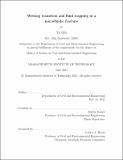Wetting transition and fluid trapping in a microfluidic fracture
Author(s)
Qiu, Yu
DownloadThesis PDF (37.57Mb)
Advisor
Juanes, Ruben
Terms of use
Metadata
Show full item recordAbstract
During immiscible fluid-fluid displacement in partial wetting regime, defending fluid is often trapped as a liquid film on solid surfaces through the mechanism of wetting transition. Here, we study the impact of roughness on wetting transition and fluid trapping in a microfluidic fracture. We demonstrate that roughness significantly reduces the capillary number threshold that onsets the wetting transition, even to a vanishing value. Above the reduced threshold, fluid is trapped in two configurations: (1) below the roughness amplitude as a thin film; (2) enveloping the rough surface as a thick film. We further show that the thin film may either remain stable or dewet as a film of uniform thickness, which is distinct from the classic viscous dewetting on smooth surface. We delineate three displacement regimes: complete displacement, thin film and thick film, in a phase diagram with theoretical criteria that govern the crossovers among them. Different displacement regime leads to distinct morphology of residual fluid at late times, which eventually determines hydrodynamics and geochemical reaction in subsurface environment.
Date issued
2021-06Department
Massachusetts Institute of Technology. Department of Civil and Environmental EngineeringPublisher
Massachusetts Institute of Technology